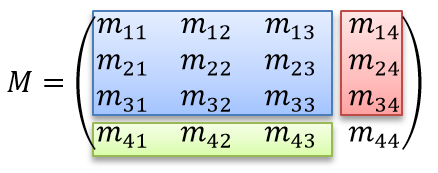I am writing some software, for my own learning experience, to convert astronomical coordinates to different frames of reference. An example of this would be conversion between ICRS which a lot of NASA data is supplied in automatically now, to Alt Azimuth, which is required for observation, based on the current time and geographic location.
From my prior studies of coordinate frames while I attended university, I know that all coordinate frames can be represented as a series of Matrix transformations from a "base" frame of reference. For instance, rotations around the X,Y,Z axis and a translation. For simplicity, these transformations are often all combined into a single affine transformation matrix like seen below where the blue section is the rotation matrix, the red is the translation, and the green is the scale.
This leads me to believe that I should be able to represent conversions from ICRS to Alt Azimuth in much the same way, though the transformation matrix will change with time/location. Based on this, the transformation matrix should look something like below where each rotation needed to create the overall transformation is a function of time, latitude, and longitude.
M = Rx(t, lat, lon) * Ry(t, lat, lon) * Rz(t, lat, lon)
However, in my googling of this topic all I can find is how to use AstroPy's built in functions to convert between different frames of reference. This is not all that useful to me as I actually want to learn about these transformations, not just be able to perform them. While I could study the AstroPy source code, it's such a massive library with a lot of interconnecting parts that understanding this one topic would take a huge time investment.
Does anyone have any experience with the mathematics involved in performing such a conversion, references to articles, or recommended textbooks that discuss the topic of conversion between different coordinate systems specifically those using a matrix format for the context of astronomy?
